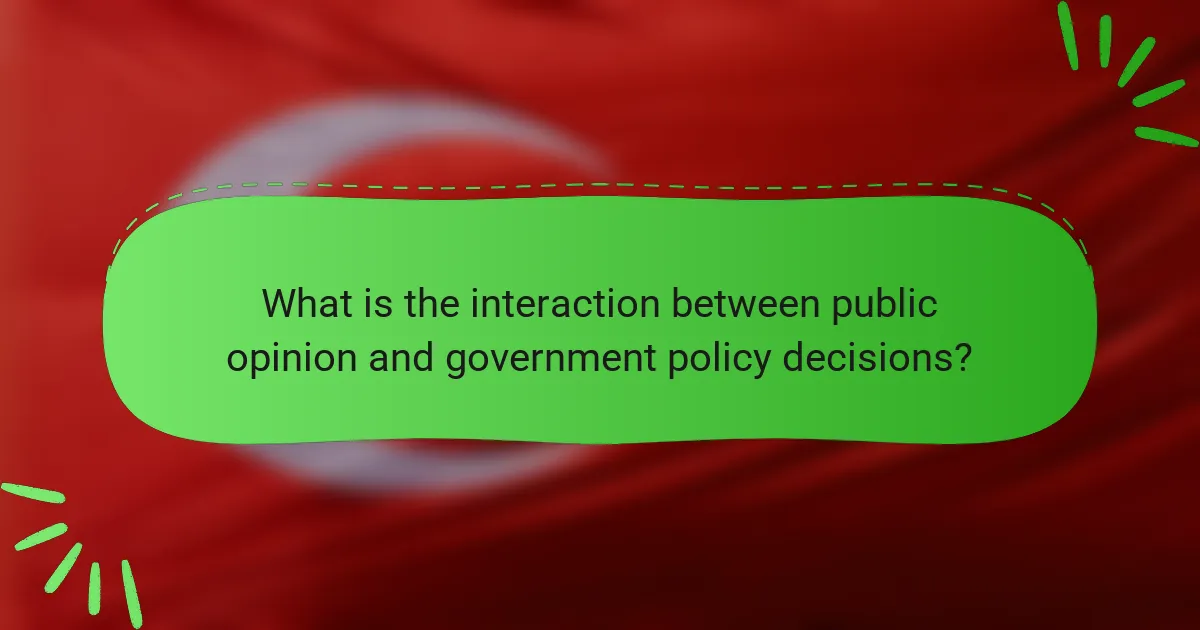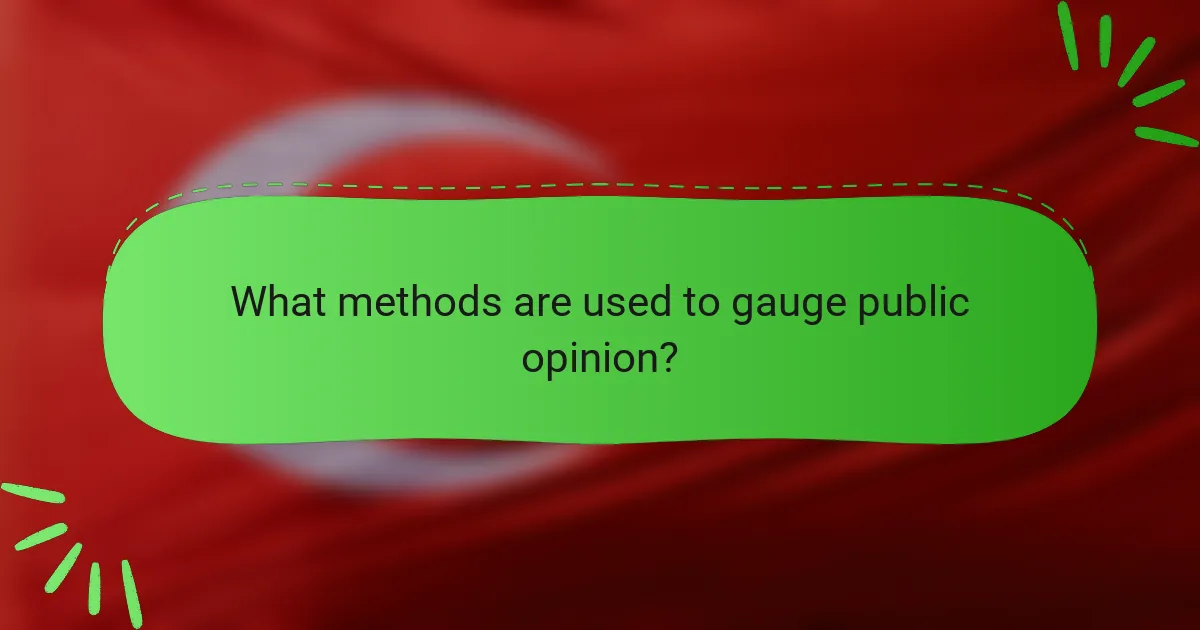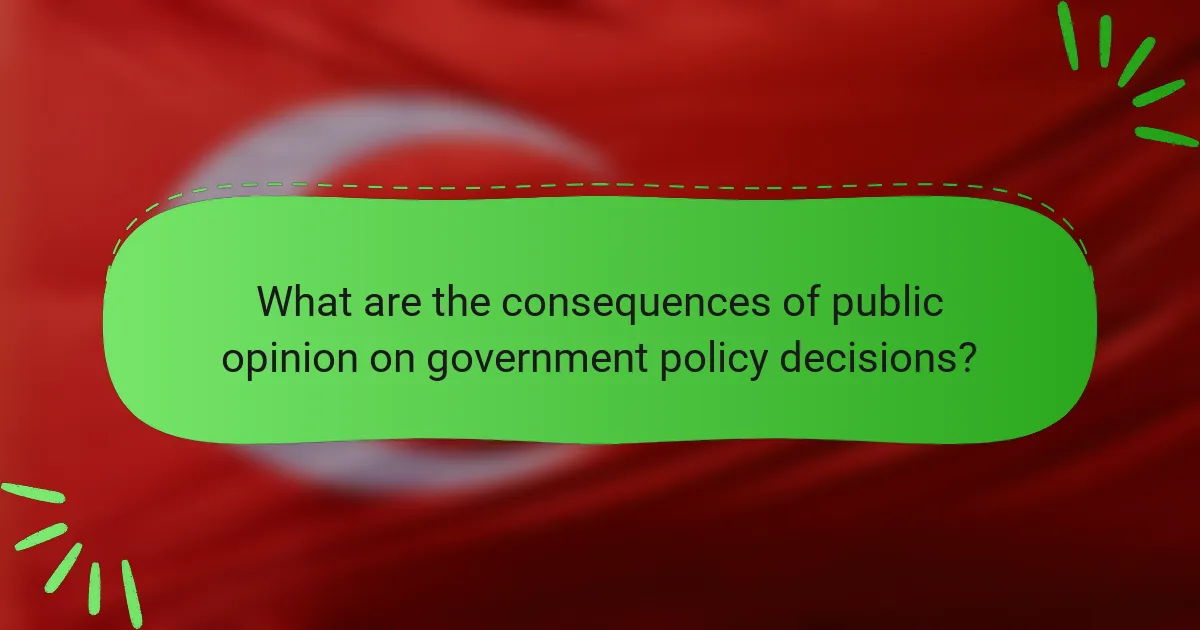Public opinion plays a crucial role in shaping government policy decisions. Policymakers utilize various methods, such as surveys, polls, and social media analysis, to gauge public sentiment and adjust their strategies accordingly. High public support can expedite the enactment of legislation, while strong opposition can lead to delays or rejections. The article examines the dynamic interaction between public opinion and government policies, highlighting examples like the Affordable Care Act and the implications for electoral outcomes. Understanding this relationship is essential for recognizing how public attitudes influence political processes and decision-making.

What is the interaction between public opinion and government policy decisions?
Public opinion significantly influences government policy decisions. Policymakers often rely on public sentiment to gauge the acceptance of proposed policies. High public support can lead to the swift implementation of legislation. Conversely, strong opposition may result in policy delays or rejections. For example, the Affordable Care Act was shaped by public opinion on healthcare reform. Surveys showed that a majority of Americans favored expanding access to healthcare. Consequently, lawmakers prioritized this issue in their agendas. Research indicates that elected officials who ignore public opinion risk losing voter support. Thus, the interaction is a dynamic process where public opinion and government policy decisions continuously influence each other.
How does public opinion shape government policy decisions?
Public opinion significantly influences government policy decisions. Policymakers often gauge public sentiment through polls and surveys. High public support for an issue can lead to legislative action. Conversely, widespread opposition may cause policymakers to reconsider proposed policies. Historical examples include the Civil Rights Movement, where public opinion shifted policies on racial equality. Additionally, public protests can compel governments to act swiftly. Media coverage amplifies public opinion, shaping perceptions and priorities. Thus, public opinion serves as a critical feedback mechanism for government actions.
What are the key factors influencing public opinion?
Key factors influencing public opinion include media, socialization, political events, and demographics. Media shapes perceptions through news coverage and commentary. Socialization occurs through family, education, and peer influences. Political events, such as elections or crises, can shift public sentiment rapidly. Demographics, including age, gender, and ethnicity, affect viewpoints and priorities. Research shows that these factors interact dynamically, impacting how opinions are formed and expressed. For instance, studies indicate that younger voters are more influenced by social media than older generations.
How do these factors translate into policy decisions?
Public opinion significantly influences government policy decisions. Policymakers often consider the views and preferences of the public to maintain legitimacy and support. For instance, surveys and polls indicate public priorities, which can lead to policy adjustments. Historical examples include the Civil Rights Movement, where public sentiment pressured lawmakers to enact legislation. Additionally, elected officials may align their policies with constituents’ opinions to secure votes. This relationship ensures that policies reflect the needs and desires of the population. Ultimately, public opinion acts as a crucial factor in shaping effective and responsive governance.
Why is understanding this interaction important?
Understanding the interaction between public opinion and government policy decisions is crucial for effective governance. Public opinion shapes the priorities and actions of policymakers. When citizens express their views, it influences the direction of policy initiatives. For instance, a survey by the Pew Research Center found that 70% of Americans believe public opinion should guide government actions. This demonstrates the significant role public sentiment plays in shaping policies. Additionally, understanding this interaction helps governments respond to societal needs and adapt to changing public attitudes. Engaging with public opinion fosters transparency and accountability in governance.
What role does public opinion play in democratic governance?
Public opinion plays a crucial role in democratic governance by influencing policy decisions and political actions. Elected officials often rely on public sentiment to guide their legislative priorities. This reliance ensures that the government remains accountable to the citizens. Surveys and polls regularly measure public opinion, providing data on voter preferences. Historical examples, such as the civil rights movement, demonstrate how public opinion can drive significant policy changes. Additionally, public opinion can shape electoral outcomes, impacting which candidates are elected. This dynamic creates a feedback loop between citizens and their representatives. Ultimately, public opinion serves as a vital mechanism for democratic engagement and accountability.
How can government responsiveness to public opinion impact societal trust?
Government responsiveness to public opinion can significantly enhance societal trust. When citizens perceive that their opinions influence government decisions, they feel valued and heard. This perception fosters a sense of belonging and engagement in the democratic process. Studies show that high responsiveness correlates with increased public trust in institutions. For instance, a Gallup poll indicated that trust in government rises when citizens believe their voices matter. Conversely, lack of responsiveness can lead to disillusionment and decreased trust. A 2018 Pew Research study found that 70% of Americans felt the government did not care about their views. Thus, effective government responsiveness is crucial for building and maintaining societal trust.

What methods are used to gauge public opinion?
Surveys and polls are primary methods used to gauge public opinion. Surveys collect data from a sample population to understand their views. Polls typically measure the popularity of specific issues or candidates. Focus groups provide qualitative insights by discussing topics in a small group setting. Social media analysis examines public sentiment through online platforms. Each method offers unique insights into public attitudes and preferences. For example, Gallup polls have historically been used to track public opinion trends in the United States.
What are the common tools for measuring public opinion?
Surveys are common tools for measuring public opinion. They gather data through questionnaires directed at a sample of the population. Polling organizations conduct surveys to assess public attitudes on various issues. Focus groups are another method, facilitating in-depth discussions among selected participants. Social media analytics track public sentiment by analyzing online discussions and reactions. Exit polls are used during elections to gauge voter preferences immediately after they cast their votes. Each tool provides insights into how the public feels about specific topics or policies. These methods are widely utilized by researchers, governments, and organizations to inform decision-making.
How do surveys and polls contribute to understanding public sentiment?
Surveys and polls provide quantifiable data on public opinion. They gather responses from a representative sample of the population. This data reflects the sentiments, preferences, and concerns of the public. For example, a Gallup poll can show approval ratings for government policies. By analyzing trends over time, researchers can identify shifts in public sentiment. This information is crucial for policymakers. It helps them align decisions with the views of their constituents. Studies have shown that public opinion can influence legislative outcomes. Therefore, surveys and polls are essential tools for understanding and responding to public sentiment.
What are the limitations of these measurement methods?
Measurement methods in assessing public opinion and government policy have several limitations. Firstly, surveys may suffer from response bias, where participants provide socially desirable answers rather than honest opinions. This can skew results and misrepresent public sentiment. Secondly, sample size and selection can limit representativeness. If the sample does not accurately reflect the broader population, findings may not be generalizable. Thirdly, the timing of data collection can impact results. Public opinion can fluctuate rapidly, making findings outdated quickly. Additionally, the wording of questions can influence responses, leading to misinterpretation. Lastly, qualitative methods like interviews may lack consistency, as they depend on individual interpretations and can introduce subjective bias. These factors collectively hinder the accuracy and reliability of measurement methods in this context.
How do media and communication affect public opinion?
Media and communication significantly shape public opinion. They influence perceptions by framing issues and setting agendas. For instance, studies show that increased media coverage of certain topics leads to higher public awareness and concern. A 2017 study by the Pew Research Center found that 62% of Americans get their news from social media. This shift impacts how people form opinions on political matters. Communication channels, including social media, allow for rapid dissemination of information. This can amplify specific viewpoints and marginalize others. The portrayal of events in the media often dictates the public’s emotional response. Consequently, media acts as a catalyst for public engagement and activism.
What role does social media play in shaping public perceptions?
Social media significantly influences public perceptions by providing a platform for information dissemination and interaction. It allows users to share opinions, news, and personal experiences rapidly. This instant communication can amplify certain narratives while diminishing others. For instance, studies show that social media can sway public opinion on political issues. Research by the Pew Research Center indicates that 64% of Americans believe social media has a major impact on their views about politics. Additionally, social media algorithms prioritize engaging content, which can lead to echo chambers. This phenomenon reinforces existing beliefs and shapes perceptions. Overall, social media acts as both a mirror and a mold for public opinion, affecting how individuals perceive societal issues.
How does traditional media influence public opinion on policy issues?
Traditional media significantly influences public opinion on policy issues by shaping narratives and framing discussions. It provides information that helps the public form opinions on various topics. For instance, studies indicate that media coverage can affect public perceptions of issues like healthcare and immigration. According to a Pew Research Center report, 62% of Americans say news organizations influence their views on political issues. This influence occurs through selective reporting and editorial choices that highlight specific aspects of policies. Traditional media also acts as a platform for debate, allowing different viewpoints to be expressed. This exposure can lead to increased public engagement and awareness of policy matters. Thus, traditional media plays a crucial role in informing and influencing public opinion on policy issues.

What are the consequences of public opinion on government policy decisions?
Public opinion significantly influences government policy decisions. Policymakers often adjust their strategies to align with the views of their constituents. High levels of public support can lead to the swift enactment of policies. Conversely, strong opposition may stall or derail proposed legislation. For example, the Affordable Care Act faced intense public scrutiny, impacting its implementation. Additionally, public opinion can shape electoral outcomes, affecting which candidates are elected. Studies show that politicians who ignore public sentiment risk losing voter support. This dynamic creates a feedback loop between public opinion and policy-making processes.
How does public opinion lead to policy changes?
Public opinion influences policy changes by shaping the priorities of lawmakers. When a significant portion of the public expresses a particular view, elected officials often respond to align with these sentiments. This alignment can occur through public protests, opinion polls, or social media trends. For instance, the widespread support for climate action in recent years has prompted governments to implement stricter environmental regulations. Historical data shows that policies like the Affordable Care Act were influenced by public demand for healthcare reform. Additionally, lawmakers may fear losing elections if they ignore prevailing public opinions. Therefore, public opinion serves as a critical driver in the policymaking process.
What historical examples illustrate this relationship?
The interaction between public opinion and government policy decisions can be illustrated through several historical examples. One significant instance is the Civil Rights Movement in the 1960s. Public protests and widespread activism led to the passing of the Civil Rights Act of 1964. This legislation aimed to end segregation and discrimination based on race.
Another example is the Vietnam War protests during the late 1960s and early 1970s. Growing public dissent influenced the U.S. government’s decision to withdraw troops from Vietnam. Public opinion shifted dramatically against the war, leading to significant policy changes.
The Watergate scandal in the 1970s also highlights this relationship. Public outrage over the scandal prompted Congress to investigate and led to President Nixon’s resignation.
These examples demonstrate how public opinion can directly impact government policy decisions, shaping the political landscape.
How do government officials respond to shifts in public opinion?
Government officials adjust policies and strategies in response to shifts in public opinion. They conduct polls and surveys to gauge public sentiment. This data informs their decision-making processes. Often, officials may alter their messaging to align with public concerns. For example, during health crises, governments may change policies based on public health opinions. Historical evidence shows that officials frequently shift stances to maintain public support. A notable instance is the U.S. government’s response to climate change, which evolved significantly as public awareness grew. Such adjustments aim to ensure that policies reflect the electorate’s priorities.
What challenges arise from the interaction between public opinion and policy decisions?
Challenges arise from the interaction between public opinion and policy decisions primarily due to conflicting interests. Policymakers often face pressure to align decisions with public sentiment. However, public opinion can be volatile and influenced by misinformation. This inconsistency can lead to policy instability. Additionally, not all segments of the population are represented equally in public opinion. Marginalized groups may have their needs overlooked. Policymakers may prioritize popular issues over critical but less visible ones. This dynamic can result in policies that are not comprehensive or effective. Historical examples include shifts in environmental policy based on changing public perceptions. Ultimately, balancing public opinion with informed policy-making remains a complex challenge.
How can conflicting public opinions complicate policymaking?
Conflicting public opinions can complicate policymaking by creating division among stakeholders. Policymakers may struggle to find common ground when opinions vary widely. This division can lead to delays in decision-making processes. It may also result in policies that satisfy no one. For example, public protests can arise from dissatisfaction with proposed policies. This can pressure lawmakers to alter or abandon initiatives. Research shows that polarized opinions can hinder legislative progress. According to a 2020 study by the Pew Research Center, 87% of Americans believe that political divisions are a major issue. This illustrates the significant impact of conflicting opinions on effective governance.
What are the risks of government ignoring public sentiment?
Governments risk losing public trust when they ignore public sentiment. This can lead to increased political unrest and protests. Historical examples include the Arab Spring, where government repression of public opinion resulted in widespread uprisings. Ignoring public sentiment may also lead to poor policy decisions that do not reflect the needs of the populace. This can result in economic consequences, such as decreased voter turnout and lower civic engagement. Additionally, governments may face challenges in implementing policies if they lack public support. In extreme cases, ignoring public sentiment can lead to regime change or significant political instability.
What best practices can enhance the interaction between public opinion and government policy?
Engaging public opinion effectively can enhance the interaction between citizens and government policy. Transparent communication fosters trust and understanding. Regular public consultations allow citizens to express their views on policies. Utilizing social media platforms can broaden participation and feedback. Policymakers should analyze public sentiment through surveys and polls. Incorporating public input into decision-making processes increases legitimacy. Collaborative platforms can facilitate dialogue between government and citizens. These practices are supported by research indicating that inclusive governance improves policy outcomes.
How can policymakers effectively engage with citizens?
Policymakers can effectively engage with citizens through transparent communication and active participation. They should provide clear information about policies and their implications. Regular town hall meetings can facilitate direct dialogue between officials and the public. Utilizing social media platforms allows for broader outreach and quicker feedback. Surveys and polls can gauge public sentiment on various issues. Collaborative decision-making processes encourage citizen involvement in policy formulation. Evidence shows that engaged citizens are more likely to support government initiatives. For instance, the National Civic Engagement Study highlights that inclusive practices lead to higher trust in government.
What strategies can be employed to ensure transparency and responsiveness?
Strategies to ensure transparency and responsiveness include regular communication, open data initiatives, and public consultations. Regular communication involves providing updates on government actions and decisions. This builds trust and keeps citizens informed. Open data initiatives make government data accessible to the public. Transparency in data allows citizens to analyze and understand government operations. Public consultations invite citizen input on policy decisions. Engaging the public fosters a sense of ownership and accountability. Additionally, feedback mechanisms enable citizens to express their concerns and suggestions. These strategies collectively enhance government responsiveness to public needs.
The main entity of this article is the interaction between public opinion and government policy decisions. The article explores how public sentiment influences policymakers, leading to the implementation or rejection of legislation based on public support or opposition. It discusses key factors that shape public opinion, such as media, socialization, and demographics, and outlines methods for measuring public sentiment, including surveys and polls. Additionally, the article highlights the importance of understanding this interaction for effective governance and societal trust, while addressing challenges and best practices for enhancing government responsiveness to public opinion.